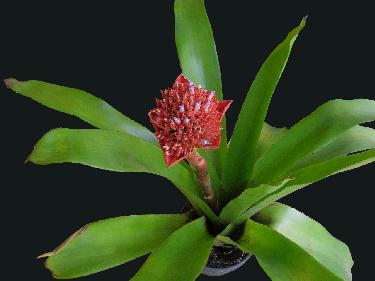
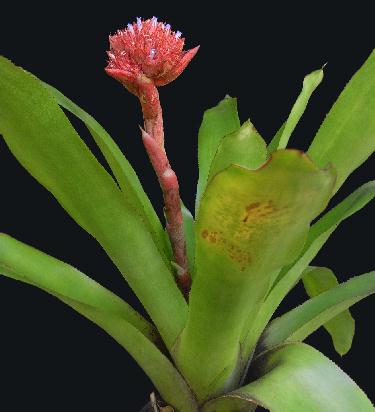
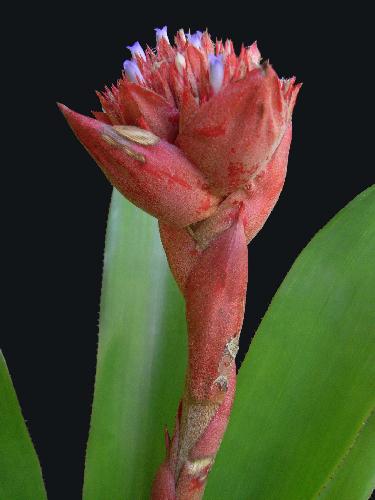
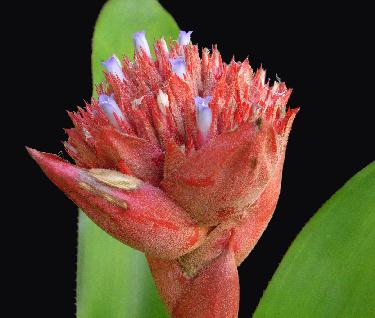
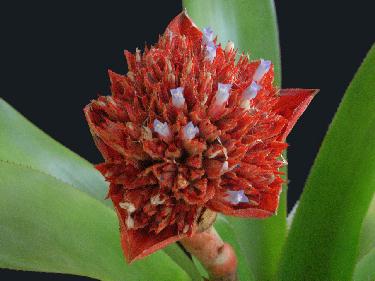
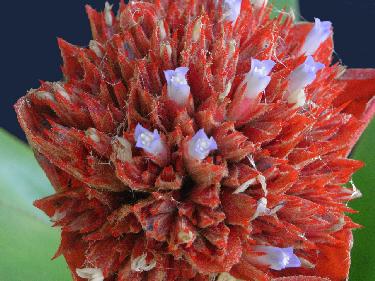
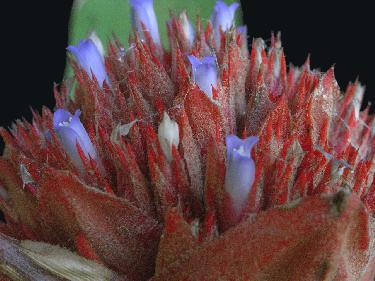
Plant flowering 1m high.
Leaves 6-10 dm long, minutely appressed-lepidote;
Sheaths elliptic, 25 cm long;
Blades ligulate, abruptly acute, apiculate, 5-7 cm wide.
Scape erect, 7-10 mm in diameter, densely brown-lanate;
Scape-bracts slightly imbricate, broadly ovate with a short stout linear pungent blade, bright rose, soon glabrous.
Inflorescence corymbose, densely subglobose, 7-8 cm in diameter, brown-lanate;
Primary bracts suborbicular, pungent-apiculate, 5-7 cm long, nearly covering the branches, bright rose;
Branches very short, subellipsoid, densely many-flowered.
Floral bracts lance-ovate, acute with a terminal mucro 3-4 mm long, slightly exceeding the sepals.
Sepals strongly asymmetric, 15 mm long exclusive of the 6 mm mucro, free;
Petals 15-20 mm long, mucronate, deep blue;
Pollen grains with 4 pores;
Ovary obconic; epigynous tube 2 mm high.
Type. Broadway 9917 (holotype, K; isotypes, NY, TRIN), Cerro del Aripo, northern Range, Trinidad, West Indies, 10-26 Jan 1922.
Distribution. Epiphytic and saxicolous in cloud forest, 900-1020 m alt, Trinidad and adjacent Venezuela.
VENEZUELA. Sucre: Peninsula de Paria, Pittendrigh 1527 (TRIN); Cerro Patao, north of Puerto de Hierro, 19 Jul 1962, Steyermark & Agostini 91102 (US, VEN). TRINIDAD. Cerro dei Aripo, Northern Range, Sep 1862, Crueger s n (TRIN 1748); 27 Oct 1921, Freeman & Broadway s n (TRIN); Broadway s n (OH); 6984 (MO); 17 Mar 1929, 7088 (US); 1942, Pittendrigh 1392 (US); 24 May 1955, Aitken & Downs s n (TRIN 61,62, US); Chaguaramal summit, Pittendrigh 1308 (TRIN); 1527 in part (TRIN); 14 Dec 1958, Aitken & Downs s n (TRIN 305).
Aechmea aripensis, Nature's Pincushion by Racine Foster in J Brom. Soc. 38(4): 166-7. 1988
In Lyman Smith's "Key to Species of Subgenus Aechmea and Simulators, "A. aripensis follows immediately A. orlandiana. That should tell you that they are morphologically close. However, A. aripensis does not have the attractive, embossed, two-toned leaf of A. orlandiana. And, A. aripensis differs from A. orlandiana with a dense, compact, subglobose head which resembles a pincushion of tightly pressed, upright, red bracts, surrounding blue flowers - an intriguing bromeliad.
Originally, this plant was collected by W.E. Broadway of Kew Gardens on the Cerro del Aripo in Trinidad, West Indies, at 3,000 feet elevation, in January 1922. His type specimen #9917 is deposited in Kew Gardens, England.
In 1926, four years after the original collection, N .E. Brown (a Sansevieria specialist at Kew) published in the Bulletin of the Torrey Club (vol. 53) a description of Gravisia aripensis, the original name of our Aechmea aripensis.
In 1958, Dr. Colin S. Pittendrigh changed the genus from Gravisia to Aechmea. The full botanical description can be found in Lyman Smith's monograph, part 3, Bromelioideae, pages 1796-1799.
Dr. Pittendrigh and Dr. Thomas Aitken were colleagues at the Trinidad Regional Virus Laboratory (Rockefeller Foundation) in Port-of-Spain, Trinidad. They were doing research on mosquitoes, a study that lead, inevitably, to their interest in bromeliads, the tank types that harbor mosquitoes.
From the time of our visit to the island in 1940, there was an accelerated interest in the bromeliads botanically and horticulturally. Thereafter, for twenty years we carried on a correspondence and exchange of plants with Dr. Aitken who became very enthusiastic about bromeliads. He tried to interest the local people in their native flora and helped set up a judged exhibition of bromeliads in the Horticultural Club show. (Lucky are the people in Trinidad-they don't have to worry about cold weather).
Dr. Aitken's enthusiasm gave him the impetus to make a drawing of the curious pincushion flower head of Aechmea aripensis which he sent to us in July 1957 along with the following description:
Scape, densely brown-lanate. Scape bracts barely imbricate, broadly ovate, glabrous. Inflorescence dense, subglobose, about 3 ½ to 4 inches across resembling a very spiny pincushion, bright red bracts with purple tinges as it ages, and tiny pale blue flowers which barely exceed the prickly sepals. Primary bracts, suborbicular, almost entirely exceeding the axillary branches. Floral bracts red with sparse covering of brown-lanate fuzz. A large plant with broad, serrate leaves.
I regret to say that we did not actually collect this fascinating bromeliad, but we intended to do so! We saw the blooming plant in Dr. Aitken's garden in Port-of-Spain in 1940 on our way home from six-months collecting in Brazil.
Of course, we were very covetous of such a curious bromeliad. It was exciting that this was a genus (Gravisia) which, at that time, we didn't know. We wanted to see how it grew in its native tropical habitat. So, since the mountain was only an hour's drive away, Dr. Aitken agreed to drive us there. But on the way, he made the fatal mistake of showing us the famous Asphalt Lake, that huge (a mile or two wide and as long) , seething mass of almost liquid tar. It is the source of all macadam roads around the world. The people of Trinidad mine this gooey gook, chill it into easily handled chunks, and ship it all over the world.
Well, we were so mesmerized by this phenomenon, unique in our experience, that we never got to the Cerro del Aripo where the Aechmea aripensis was awaiting us from a tree or rock. We had to be satisfied with a specimen from Dr. Aitkin's garden because our ship was ready to sail. Although it was a thwarted collecting trip, we retained most enjoyable memories of Dr. Aitken's kind attention in fascinating Trinidad.